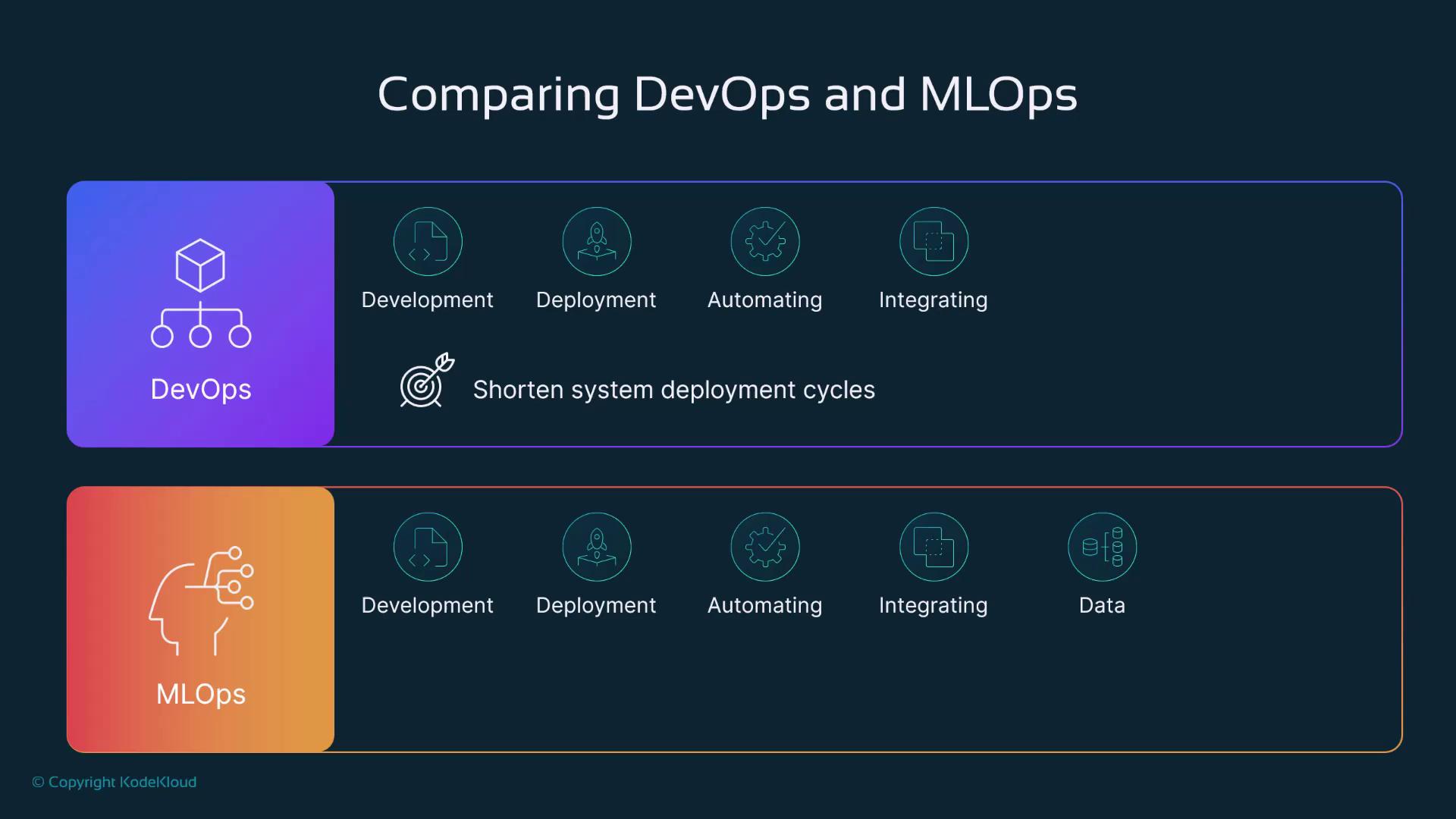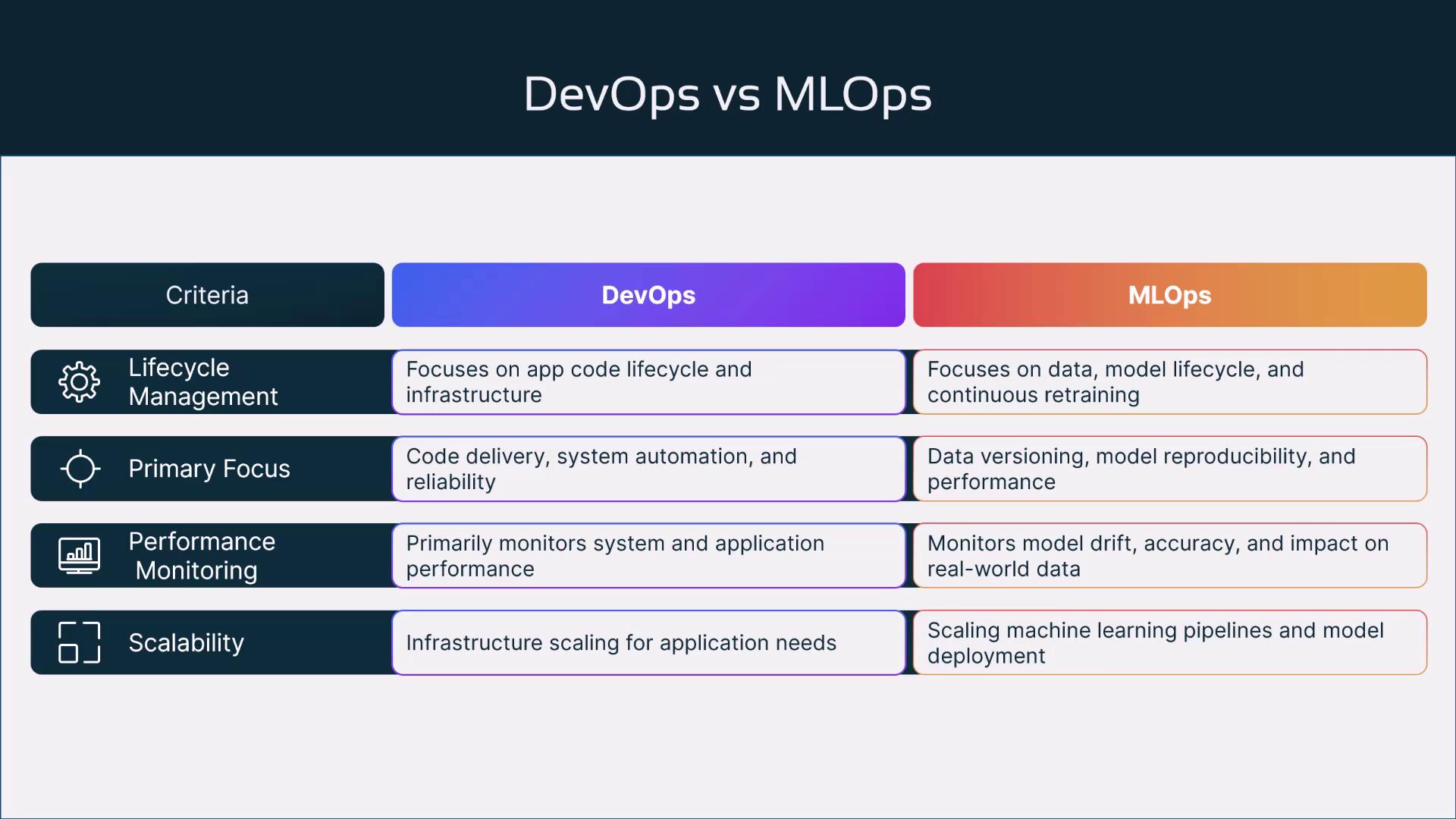Fundamentals of MLOps
Introduction to MLOps
DevOps and MLOps A Comparison
Welcome to this comprehensive comparison of DevOps and MLOps. In this lesson, we explore how these methodologies share the goal of streamlining development and deployment processes while catering to different challenges within modern software and machine learning workflows.
Both DevOps and MLOps are designed to enhance productivity and reliability. However, DevOps primarily focuses on the continuous integration, delivery, and deployment of software in IT environments, whereas MLOps extends these principles to cover the intricacies of machine learning model development, deployment, and maintenance.

Key Understanding
Recognizing the differences between DevOps and MLOps is essential. It allows you to determine which methodology aligns better with your team's skill set and project requirements.
Overall Purpose
DevOps is centered on advancing software development and IT operations. Its core practices, including continuous integration, delivery, and deployment, help organizations accelerate software updates. For instance, an e-commerce company might leverage DevOps to automate website updates and facilitate swift, reliable releases.
In contrast, MLOps is specifically designed to support the machine learning lifecycle—from data ingestion and model training to deployment and monitoring. A financial services company could use MLOps to develop and deploy a fraud detection model, ensuring continuous monitoring and retraining as new data emerges.
Collaboration and Roles
Effective collaboration is the backbone of both methodologies:
DevOps: Involves developers, IT operations personnel, and security teams working in harmony to build secure, efficient continuous delivery pipelines. For example, cross-functional teams might work together to automate the deployment of a microservices-based application.
MLOps: Brings together data scientists, machine learning engineers, DevOps experts, and analysts. In a healthcare technology setting, these specialists collaborate to build, deploy, and monitor predictive models for patient outcomes.
In a typical DevOps scenario, engineers and system administrators work closely with software developers to automate infrastructure management. On the other hand, MLOps engineers partner with data scientists and machine learning engineers, ensuring effective lifecycle management of ML models.
Key Tools
Both methodologies have a unique set of tools that support their processes:
| Methodology | Key Tools | Example Use Case |
|---|---|---|
| DevOps | Jenkins, Docker, Kubernetes, Ansible, Terraform | Automating container orchestration for a web application across environments |
| MLOps | MLflow, DVC, Kubeflow, Airflow | Managing model versioning, data pipelines, and automating model retraining |
For instance, DevOps teams often use Docker in combination with Kubernetes to deploy and manage applications, while MLOps teams might rely on Airflow to automate the periodic retraining of a machine learning model.

Lifecycle Management and Focus Areas
Lifecycle Management
DevOps: Focuses on the application code and the supporting infrastructure through continuous integration, testing, and deployment. An example is a cloud-based application that benefits from automated release cycles.
MLOps: Encompasses not only the model itself but also the data lifecycle and continuous retraining. Consider an autonomous vehicle company that continuously updates its models as new sensor data is collected.
Primary Focus and Performance Monitoring
DevOps: Emphasizes reliable code delivery, system automation, and overall operational stability. For example, an IoT-based agriculture company might use DevOps practices to maintain high uptime and scale services as needed.
MLOps: Prioritizes data versioning, model reproducibility, and monitoring performance metrics such as model drift and accuracy. An e-commerce platform might rely on MLOps to monitor the effectiveness of a fraud detection algorithm in real-time.
Scalability
DevOps: Aims to scale infrastructure to handle growing user volumes and increased application demands.
MLOps: Focuses on scaling machine learning pipelines and ensuring that model deployments can serve millions of users efficiently.

Conclusion
In summary, although DevOps and MLOps share the objective of streamlining development and deployment processes, they cater to distinct operational needs. DevOps is about optimizing software development, IT operations, and infrastructure management. In contrast, MLOps addresses the challenges specific to machine learning, including model lifecycle management, data handling, and performance monitoring.
Final Thought
Choosing between DevOps and MLOps—or integrating both—should be based on your project requirements and team expertise. This understanding ensures you are equipped to handle not only software deployment challenges but also the unique demands of machine learning systems.
Watch Video
Watch video content